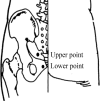Comparison of efficacy and safety between electroacupuncture at 'four sacral points' and conventional electroacupuncture for the treatment of urinary incontinence after stroke: study protocol for a randomised controlled trial
- PMID: 30397007
- PMCID: PMC6231555
- DOI: 10.1136/bmjopen-2018-021783
Comparison of efficacy and safety between electroacupuncture at 'four sacral points' and conventional electroacupuncture for the treatment of urinary incontinence after stroke: study protocol for a randomised controlled trial
Abstract
Introduction: Electroacupuncture at 'four sacral points', also known as electrical pudendal nerve stimulation therapy, combines the advantages of pudendal nerve neuromodulation and the technique of deep insertion of long acupuncture needles. It has been used to treat stress urinary incontinence, female urgency-frequency syndrome, idiopathic urgency urinary incontinence and neurological bladders in previous studies. Here, we describe the protocol for a randomised controlled trial for evaluation of the efficacy and safety of electroacupuncture at 'four sacral points' for the management of urinary incontinence after stroke.
Methods and analysis: This is an open-label randomised controlled trial with blinded assessments and analyses. A total of 140 eligible patients will be randomly allocated to two groups. The treatment group (n=70) will receive electroacupuncture at 'four sacral points' along with routine medical care, while the control group will receive conventional electroacupuncture along with routine medical care. Twenty treatment sessions will occur over a period of 4 weeks. The primary outcome measures will be the self-recorded findings in an incontinent episode diary at baseline and at 4 weeks after baseline. The secondary outcome measures will be the International Consultation on Incontinence Questionnaire Urinary Incontinence-Short Form (ICIQ-UI SF) score and the Barthel Activities of Daily Living Index (Barthel ADL Index) score at baseline and at 4 and 28 weeks after baseline.
Ethics and dissemination: This protocol has been approved by the Ethics Committee of the First Affiliated Hospital of Zhejiang Chinese Medical University (approval No. 2018-K-059-01). Written informed consent will be obtained from each participant. The results of the study will be published in peer-reviewed journals.
Trial registration number: ChiCTR-IOR-17012847; Pre-result.
Keywords: complementary medicine; stroke; stroke medicine; urology.
© Author(s) (or their employer(s)) 2018. Re-use permitted under CC BY-NC. No commercial re-use. See rights and permissions. Published by BMJ.
Conflict of interest statement
Competing interests: None declared.
Figures




Similar articles
-
Effectiveness of repetitive transcranial magnetic stimulation against poststroke urinary incontinence: a study protocol for a randomized controlled trial.Trials. 2022 Aug 13;23(1):650. doi: 10.1186/s13063-022-06535-y. Trials. 2022. PMID: 35964135 Free PMC article.
-
Efficacy of electrical pudendal nerve stimulation versus pelvic floor muscle training in treating postradical prostatectomy urinary incontinence: study protocol for a randomised controlled trial.BMJ Open. 2023 Jan 5;13(1):e062323. doi: 10.1136/bmjopen-2022-062323. BMJ Open. 2023. PMID: 36604129 Free PMC article.
-
Clinical Efficacy of Electroacupuncture at Sacral Four Points Combined with Moxibustion at Abdominal Three Points for Treating Post-Stroke Urinary Incontinence: Observations on Urodynamics, Quality of Life, and Safety.Arch Esp Urol. 2024 Aug;77(7):732-738. doi: 10.56434/j.arch.esp.urol.20247707.102. Arch Esp Urol. 2024. PMID: 39238296
-
Moxibustion for post-stroke urinary incontinence in adults: A systematic review and meta-analysis of randomized controlled trials.Complement Ther Clin Pract. 2021 Feb;42:101294. doi: 10.1016/j.ctcp.2020.101294. Epub 2020 Dec 24. Complement Ther Clin Pract. 2021. PMID: 33360387
-
Is electroacupuncture safe and effective for treatment of stress urinary incontinence in women? A systematic review and meta-analysis.J Int Med Res. 2020 Oct;48(10):300060520948337. doi: 10.1177/0300060520948337. J Int Med Res. 2020. PMID: 33045874 Free PMC article.
Cited by
-
Vagus Nerve Stimulation and Sacral Nerve Stimulation for Inflammatory Bowel Disease: A Systematic Review.J Transl Gastroenterol. 2023 Oct-Dec;1(2):94-100. doi: 10.14218/jtg.2023.00098. Epub 2023 Dec 25. J Transl Gastroenterol. 2023. PMID: 38606364 Free PMC article.
-
Biofeedback combined with percutaneous electrical pudendal nerve stimulation for the treatment of low anterior rectal resection syndrome: a study protocol for a randomized controlled trial.Trials. 2024 Jul 2;25(1):440. doi: 10.1186/s13063-024-08300-9. Trials. 2024. PMID: 38956630 Free PMC article.
-
Electroacupuncture regulates histone acetylation of Bcl-2 and Caspase-3 genes to improve ischemic stroke injury.Heliyon. 2024 Mar 4;10(6):e27045. doi: 10.1016/j.heliyon.2024.e27045. eCollection 2024 Mar 30. Heliyon. 2024. PMID: 38500994 Free PMC article.
-
The efficacy and safety of electroacupuncture against urinary incontinence after stroke: A protocol for systematic review and meta analysis.Medicine (Baltimore). 2020 Sep 18;99(38):e22275. doi: 10.1097/MD.0000000000022275. Medicine (Baltimore). 2020. PMID: 32957379 Free PMC article.
-
Effectiveness of repetitive transcranial magnetic stimulation against poststroke urinary incontinence: a study protocol for a randomized controlled trial.Trials. 2022 Aug 13;23(1):650. doi: 10.1186/s13063-022-06535-y. Trials. 2022. PMID: 35964135 Free PMC article.
References
-
- Abrams P, Andersson KE, Birder L, et al. . Fourth International Consultation on Incontinence Recommendations of the International Scientific Committee: Evaluation and treatment of urinary incontinence, pelvic organ prolapse, and fecal incontinence. Neurourol Urodyn 2010;29:213–40. 10.1002/nau.20870 - DOI - PubMed
Publication types
MeSH terms
Associated data
LinkOut - more resources
Full Text Sources
Medical
